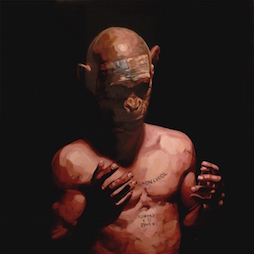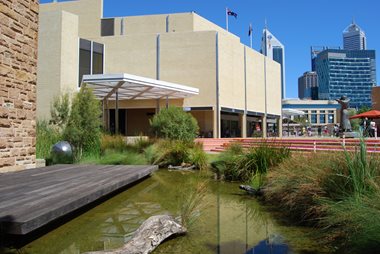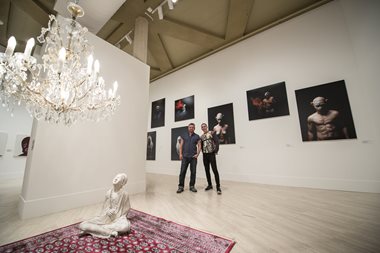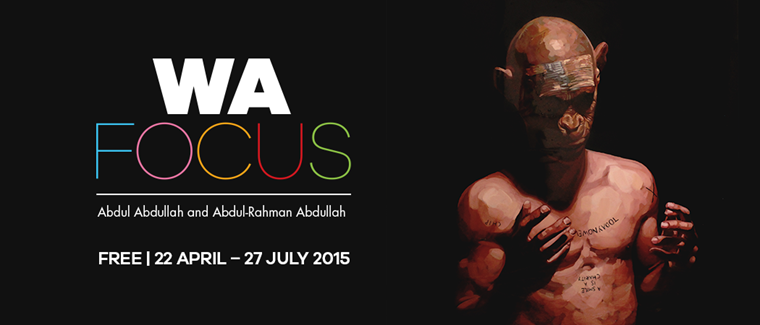 Future Focus: where to next for the
Future Focus: where to next for the
Art Gallery of Western Australia?
June Moorhouse
“We embrace boldness. We are determined to evolve, explore new directions and push beyond the boundaries of the expected…”
These lines from the Art Gallery of Western Australia’s recently published manifesto, The Essence of AGWA are echoed by the gallery’s director, Stefano Carboni as he discusses the future of the gallery with Artsource. “We want to drive things. We want to be bold,” he says.
While most arts lovers would applaud this sentiment, given the recent history and current operating context for the gallery, deeper questions remain. Just what is boldness, what might it look like at AGWA and how will it be achieved in straightened financial times?
Fresh from his role as Curator of Islamic Art at The Metropolitan Museum of Art in New York (MoMA), Carboni assumed the Director’s role in 2008 and says that his mandate was to ‘make this institution an international institution’. In response he set about creating a range of exhibitions in concert with some of the best collections in the world, first negotiating smaller exhibitions with the Victoria and Albert Museum and the Peggy Guggenheim collection, before moving on to work with Glenn Lowry at MoMA in New York to plan the ambitious MoMA series. Leveraging his international networks to the full, Carboni was successful in attracting some extraordinary artworks to AGWA, and the six exhibitions in the MoMA series promised Perth audiences customized showings of some of the world’s most revered contemporary artists.
On the back of this vision Carboni attracted additional state government investment of $6m, successfully exciting, it seems, WA leaders in government and business with his bold proposition. As has been well documented, the MoMA series collapsed weeks before the fourth exhibition was due to open. Insurance costs are cited as the main challenge in continuing the series. The original business case was predicated on the existing government indemnification scheme upon which AGWA relies, being sufficient to cover the series. However, as Carboni says, “I was, in a way, the victim of Glenn Lowry’s generosity because if you recall those works in that first exhibition Picasso to Warhol… it was a phenomenal show. It was way more than any former exhibition that they had ever indemnified.”
Rather than take on the risk, the state government gave AGWA additional funds to source commercial insurance for the exhibitions. “This compromise meant that government was spending much more than anticipated, in addition to the $6m they already gave. So it worked for three exhibitions and then the triple A rating started to go down…savings mode (came in) and when I produced all the anticipated costs for the remaining exhibitions, they said ‘no’.
 “For me as CEO there was really no choice. It was a tragic board meeting but there was nothing I could really do about it at that point.”
“For me as CEO there was really no choice. It was a tragic board meeting but there was nothing I could really do about it at that point.”
The early press coverage of the MoMA pin-pulling gave limited coverage of this issue but made much of Carboni’s comments about Perth audiences “not being ready” for the exhibitions. This damaging piece of communication reveals a further miscalculation with the MoMA experiment. Carboni explains, “I was convinced that the word ‘MoMA’ would generate immediate attraction and so in my mind 80% of Perth people would know what MoMA was and they would come without much marketing.” Subsequent surveys revealed that 15% of Perth people were aware of what MoMA stood for. “I was probably voicing my disappointment that we had to start from the very beginning,” he reflects.
Although much of this is now water under the bridge (with much learning to be gained from it), Carboni goes over it to explain that his intention was to use these internationally driven exhibitions to create what he calls “a higher platform” for AGWA – increased public awareness of the gallery, higher visitor numbers, improved support from government and with that, a stronger base from which to attract private and corporate support. This would combine to underpin growth of future local, national and international programming. The recent articulation of AGWA’s new direction, he says, is always where he wanted to go, but to do so from the springboard of the MoMA success.
The strategic arc of this thinking was bold, as were the exhibitions that provided access to remarkable international works - one of the key things one would wish for from a state gallery. Despite the fact that it immediately threw emphasis on importing artistic credibility rather than building from the ground up, there is little question that if the strategy were not derailed by crucial miscalculations, AGWA would now be in a strengthened position politically and with the public. As it is, Carboni and his team are now laying out a future blueprint in constrained circumstances.
The Essence document is a distillation of hours of deliberation and discussion internally. The first outcome of this process was a 28 page document that was shared with the board, senior staff and peers before being summarised in four pages for debate with all staff, then arriving at the final public statement. It reads like a personal promise to the reader, articulating what is important to AGWA and what AGWA will do for ‘you’ – “whether you are a Western Australian or a visitor to our wonderful State, a seasoned artistic traveller or an apprentice explorer, adult or child.“
If ‘you’ are a contemporary artist living and working in WA you may be carefully reading this manifesto. There has been long-standing criticism of AGWA’s aloofness from the WA visual arts community with many critics suggesting that not since the days of John Stringer’s tenure as senior curator has the gallery fostered an open and positive relationship with a cross section of local contemporary artists. Not surprisingly, such criticism ruffles feathers and has been regularly countered with reminders that AGWA’s remit goes well beyond supporting local artists and questioning the potentially self-serving nature of the complaints. This defensive response pre-dates Carboni and is arguably enculturated into the institution. Over time this to and fro has engendered an unfortunate stand off between AGWA and some in the visual arts. Carboni is not the first director confronting this rocky terrain.
“This is a big discussion with my curators and with my visitor experience manager: how can we make, in general, the community here a bit more involved in what we do, because clearly there is an issue. And without giving up what is our role.”
Here Carboni drills in to his view of the gallery’s primary roles, collecting and exhibiting.
“As I think I wrote two years ago in an editorial for Artsource, we have a body of curators, a body of experts, and we have to make hard decisions as to who we collect. Certainly we want to be the best collection of WA art, in addition to being a very representative collection of Australian art and what we can do outside that. But I won’t accept someone coming to me and saying, ‘Oh, you acquired one of my pieces in 1980 and you haven’t collected me anymore.’ My answer would be simple: we have looked into what you have done in the past 25 years and there is nothing that we feel is for the collection. We have the expertise – we may be mistaken, I am not saying we are gods in this respect – but certainly we are collecting those artists we believe are important for the collection for the state of Western Australia for all kinds of people. So while the artists are one of our biggest stakeholders, and certainly one of the most vocal, we don’t cater only to them. We cater to the entire community.”
Latest figures indicate the Collection holds 17,331 works, of which just over 12,000 (69.5%) are Australian works. Of this, 4,233 (24.4%) are works by WA artists.
In terms of exhibitions, Carboni’s comments reflect the Essence document’s commitment to, ‘present Western Australian art alongside that of the rest of the world, staging conversations between the local, national and international.‘
Nevertheless, a much talked about feature of the 2015 exhibition program is the new WA FOCUS space, which according to AGWA’s website will allow it to, ‘work closely with Western Australian artists and the art community to present exhibitions that display the range and depth of our state’s creative talent.’
 The space kicked off in April with the ubiquitous Abdullah brothers and throughout this year will feature Helen Smith, Graham Miller and the Proximity Festival.
The space kicked off in April with the ubiquitous Abdullah brothers and throughout this year will feature Helen Smith, Graham Miller and the Proximity Festival.
Carboni cites the Abdullah’s work as an example of embracing boldness. This offers a clue to what may prove a challenge in the unfolding of the manifesto, that is, the idea that boldness for the gallery lies in the art itself rather than in bold decisions and leadership by the institution. Abdul Abdullah’s work has been exciting curators and audiences since his graduation from Curtin University in 2008. He has shown across Australia and is held by numerous public collections, including the National Art Gallery of Australia. Graduating four years later, brother Abdul Rahman Abdullah has demonstrated a similar stellar trajectory. So while their work may be bold, and their inclusion in the program completely warranted, the choice to debut the new space with this power pair does not represent risk taking by AGWA. Similarly, the Proximity Festival is sure to offer another unique and kooky event this year, but this particular programming risk has previously proven its place in three successive iterations at the Blue Room Theatre, PICA and Fremantle Arts Centre.
There has been significant re-structuring of the curatorial team since the departure of Gary Dufour as Chief Curator and Deputy Director in 2013. Four curators have left in the last year and a half, although some re-hiring is now underway. Much of this is in response to organisational change and the budget erosion that results from the ‘efficiency dividends’ regularly meted out to all its agencies by the state government. Carboni now actively leads a team of four senior curators with Jenepher Duncan in Contemporary Australian Art, Melissa Harpley, Historical and Robert Cook in International Art. Recruitment of the Aboriginal and Torres Strait Island Curator is in progress. Dunja Rmandic has also just been appointed Associate Curator Projects, working across the curatorial team.
Carboni is also in the process of recruiting a Director Audience Stakeholder Engagement to the executive team, a position he says he fought hard for. “I hope to have someone very committed and energetic, maybe not even coming from the museum world... Someone with a good strategic, creative mind, who will oversee quite a lot of the business.” While this makes sense given Carboni’s focus on curatorial matters, the erosion of resources throughout the organisation has created staff shortages at all levels. To maintain the effectiveness of the gallery and staff morale, he must juggle executive leadership needs with operational capacity and ensure the ability of staff to implement existing or new programs.
.jpg.aspx) Leadership at Board level has also undergone change with legal and literary stalwart Nicholas Hasluck appointed in early 2015 and assuming the Chair following Fiona Kalaf’s retirement last June.
Leadership at Board level has also undergone change with legal and literary stalwart Nicholas Hasluck appointed in early 2015 and assuming the Chair following Fiona Kalaf’s retirement last June.
Ernst and Young Managing Partner Michael Anghie is another new contributor to the Board along with Andrew Forrest who moved across from his role as Chair of the AGWA Foundation. Adrian Fini now takes on that crucial task of driving fundraising for the institution. The most recent appointment of independent gallery owner Seva Frangos adds curatorial credibility to the mix, and a degree of history given her decade as Deputy Director/Director of Exhibitions and Development for AGWA until 1997. Together with remaining Board members Helen Carroll Fairhall, Jason Ricketts, Trish Risdale, Brian Roche and the Director, they must steer the ship through a period of reinvention in straightened times.
Partnerships are one way of making the dollars go further as well as opening up to new networks and audiences, and there has been a noticeable shift in AGWA’s engagement with collegiate organisations in recent years. Extending weekend opening hours and operating the rooftop bar during this year’s Fringe World was a welcome sight, particularly after the silliness of swathes of art lovers walking past the gallery’s closed doors during the 2013 Fringe, the very time when AGWA was promoting Picturing New York: Photographs from the Museum of Modern Art from the ‘city that never sleeps’.
In 2014 the high profile PICA/PIAF collaboration to present William Kentridge’s The Refusal of Time as well as presenting Tristan’s Monsters and associated workshops with Awesome Arts and DADAA indicated a broadening connection to the arts sector. Hosting Proximity Festival this year and combining FTI’s Indigenous Community Stories program with the gallery’s ambitious Desert, River, Sea Kimberley project are further examples of the gallery opening out to collegiate organisations and their audiences.
While these are positive indicators for increased opportunities to engage with the gallery, the disappointments of the past have left artists wary. And herein lies a challenge. To realize a bold future, the cash-strapped and somewhat battered gallery needs to lead with conviction and courage; curatorial courage to create a bold and engaging program as Western Australia’s leading public gallery, political courage in advocating for its place and the arts more broadly, and the courage to embrace the visual arts community as key contributors to its cause. If this boldness underpins AGWA’s effort to ‘push beyond the boundaries of the expected’, we may share a much brighter future.

June Moorhouse is an arts business consultant and writer. She works with artists and organisations to realise their full creative potential. June has a long history of working in the arts across all sectors, in Western Australia and nationally. She is a former journalist, Director of Fremantle Arts Centre, Australia Council Fellow and has been a consultant for 12+ years.